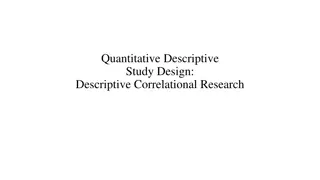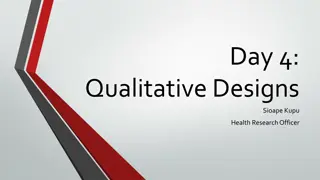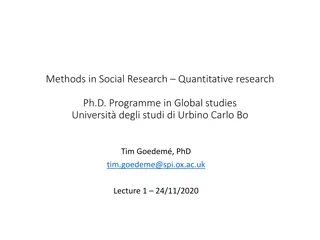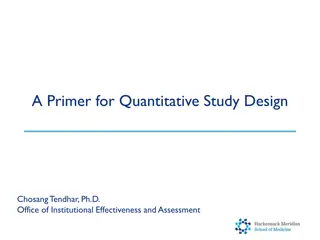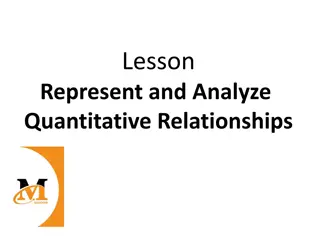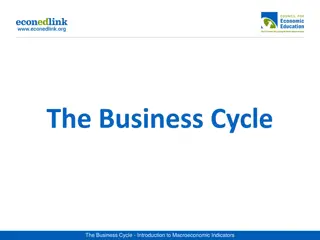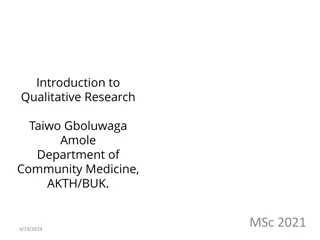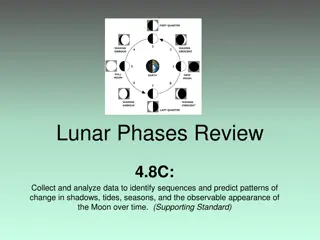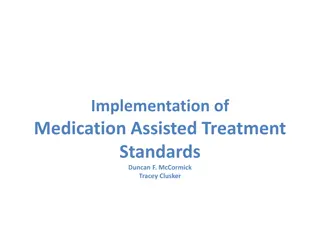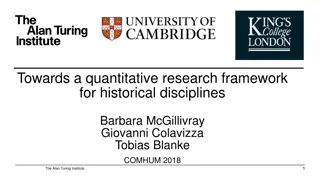Overview of Research Process and Quantitative Research Phases
The research process involves steps like identifying, locating, assessing, and analyzing the research question to find answers. It includes quantitative and qualitative approaches, with specific phases like conceptual, design, empirical, analytic, and disseminating phases in quantitative research. Essential aspects include formulating the research problem, reviewing literature, determining study objectives, and developing a conceptual framework.
Download Presentation

Please find below an Image/Link to download the presentation.
The content on the website is provided AS IS for your information and personal use only. It may not be sold, licensed, or shared on other websites without obtaining consent from the author. Download presentation by click this link. If you encounter any issues during the download, it is possible that the publisher has removed the file from their server.
E N D
Presentation Transcript
STEPS OF RESEARCH PROCESS PREPARED BY:HENSA C A LECTURER JMCON
RESEARCH PROCESS It is a step by step process involves identifying, locating, assessing and analysing the research question then developing and expressing your ideas in order to find answer and ways in which they are carried out. - Quantitative research process - Qualitative research process 3
STEPS OF QUANTITATIVE RESEARCH PROCESS The quantitative research process can be broadly categorized into the following phases: Conceptual phase Design and planning phase Empirical phase Analytic phase Disseminating phase
CONCEPTUAL PHASE Formulating the research problem Review of literature Determine the study objective Developing conceptual framework Formulating hypothesis and assumption
FORMULATING THE RESEARCH PROBLEM Generally start with broad topic area and later narrowed tospecific topic of the study PICOT model guide for formulating a clinical researchquestion P- Population I- Intervention C- Comparison group O- Outcome of interest T- Time Check 4 Dimension Substantive dimension Methodological dimension Practical dimension Ethical dimension
REVIEW OF LITERATURE A literature review is a summary of previous knowledge generated on the topic of study. Review of literature helps the researcher to understand what is already known about the topic and what needto be further investigated. The sources of ROL such as books, journals, research report, unpublished theses, newspaper, magazines,and electronic data base,
DETERMINING STUDY OBJECTIVES There must be a clear direction to every research project and objectives certainly serve this purpose. It may be general and specific objective for a research project. This step of research process also includes writing operational definition of the variables under the study.
DEVELOPING CONCEPTUAL FRAMEWORK The basic aim of quantitative research in most discipline is to develop, refine or test theories. Most of the nursing researcher plan to develop a conceptual framework based on the existing nursingor non nursing theories. The conceptual framework not only provide meaning to research problem but also help in developing hypothesis or assumptions for research study. 9
FORMULATING HYPOTHESIS Hypothesis suggesting an which may or may not be true. It is a prediction of what is expected to be the outcome of the study, which is either accepted or rejected is assumed answer to a question, statement
DESIGN AND PLANNING PHASE Selecting the research approach anddesign Developing intervention protocols Specifying the population Designing the sample plan Developing tool for data collection Establishing ethical consideration Finalising the research plan
RESEARCH APPROACH/DESIGN Research design is the blue print of research study, which enables the researcher to know on whom, what, when, where, and how the study will be conducted. Experimental it must have three characteristics that is manipulation, randomization and controlgroup Quasi experimental- it involve manipulation of independentvariable to observe the effect on dependent variables, but usually there is absence of randomization or controlgroup. Non experimental it involve study of research variables without manipulation them in natural setting for the purpose ofdescription, exploration, explanation, and correlation between two ormore variables.
SPECIFY THE POPULATION Research population is an aggregate of all the subjects or objects with specific characteristics. ( E.g.) A study on prevalence of health care associated infection amongpatient admitted in ICU DEVELOPING TOOL FOR DATA COLLECTION This is the most important and crucial step of the research process the tool for data collection depends on several factor such as type of research design, variables, subjects,available resources and time for the study. The researcher use standardized tool or develop new tool,it must be used after establishing their validity and reliability.
ESTABLISHING ETHICAL CONSIDERATION Obtaining ethical approval from IEC Taking informed consent from participants Obtaining the permission from competent authority ofa health care facility Maintaining confidentiality of the information CONDUCTING PILOT STUDY Pilot study is a kind of small scale rehearsal on the subjects, but these subjects are not a part of the actualstudy Pilot study conducted to ensure the feasibility of thestudy and revise methodology and tool of thestudy.
EMPIRICAL PHASE Data collection Preparation of data foranalysis
SAMPLE SELECTION It is not practically possible to conduct study on entire population. Therefore researcher must select representative Part of the population A sample can be selected by using either probabilityor non probability sampling techniques. DATA COLLECTION It is most time consuming steps of research process which involves direct or indirect interaction to getinformation Data collection require adequate planning, patience, communication, and IPR. Data could be collectthrough questioning, interviewing, or observationmethods
PREPARING DATA FORANALYSIS In Quantitative studies careful checking of every toolfor its completeness and coding is the main activity during this step of research process It must ensure that one code specifies only one pieceof information, and it should be maintained carefully to avoid any error. Coding can be carried out manually on a paper sheet, or computer grading sheet or directly in statisticalsoftware
ANALYTIC PHASE: TASKS ANALYSING DATA & INTERPRETING THE FINDINGS In quantitative research studies numerical data mustbe organised in an orderly and sequential manner, and analysis and interpretation of data using appropriate descriptive and inferentialstatistics. Data may be analysed either manual calculation or by using statistical programme for social sciences(SPSS), Epi- info, STATA, Minitab PASS. Data is presented through tables, graphs, and chart.
DISSEMINATION PHASE: TASKS COMMUNICATING THE FINDINGS Research finding may be communicated through writing of research thesis, article, or presentation an oralresearch report at scientific conference UTILIZING THE FINDINGS IN PRACTICE
STEPS IN QUALITATIVE RESEARCH PROCESS
STEPS IN QUALITATIVE RESEARCH PROCESS
1.Planning the study 2.Developing data collection strategies 3.Gathering and analysing data 4.Disseminating findings
PLANNING THE STUDY Identifying the research problem Doing a literature review Developing an overall approach Selecting and gaining entry into research sites Developing methods to Safeguard the participants
DEVELOPING DATA COLLECTION STRATEGIES Deciding what type of data to gather and how to gather them Deciding from whom to collect the data Deciding how to enhance the trustworthiness
GATHERING AND ANALYSING DATA Collecting data Organizing and analysing data Evaluating data: making modification to data collection techniques, if necessary Evaluating data; determining saturation has been achieved
DISSEMINATING FINDINGS Communicating findings Utilizing findings in practice and future research





